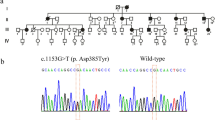Abstract
We describe a Japanese family with an autosomal dominant multiple epiphyseal dysplasia (MED EDM2) showing significant phenotypic diversity among the five affected members. Genomic analysis for COL9A2 identified an Ex3-1A>G heterozygous mutation, which has been proved to result in skipping of exon 3. The proband was a 9-year-old boy, who presented with ulnar club hands due to severe epiphyseal dysplasia in the distal ulnae. Radiological examination showed multiple epiphyseal dysplasias, predominantly involving the knee and the wrist. The hip appeared almost normal. The malalignment of the wrist was successfully treated with a limb lengthening procedure. The phenotype of the asymptomatic 12-year-old brother was similar to, but milder than, that of the proband. The asymptomatic 39-year-old mother, the 35-year-old uncle, and the 65-year-old grandmother with bilateral painful knees showed radiographically mild and severe osteoarthritis of the knee, respectively, and none of them had wrist deformity.





Similar content being viewed by others
References
Spranger JW, Brill PW, Poznanski AK (2002) Multiple epiphyseal dysplasia. In: Spranger JW, Brill PW, Poznanski AK (eds) Bone dysplasias: an atlas of genetic disorders of skeletal development. Oxford University Press, New York, pp 141–146
Briggs MD, Chapman KL (2002) Pseudoachondroplasia and multiple epiphyseal dysplasia: mutation review, molecular interactions, and genotype to phenotype correlations. Human Mutat 19:465–478
Jakkula E, Makitie O, Czarny-Ratacjzak M, Jackson GC, Damignani R, Susic M, Briggs MD, Cole WG, Ala-Kokko L (2005) Mutations in the known genes are not the major cause of MED; distinctive phenotypic entities among patients with no identified mutations. Eur J Hum Genet 13:292–301
Eyre DR, Pietka T, Weis MA, Wu JJ (2004) Covalent cross-linking of the NC1 domain of collagen type IX to collagen type II in cartilage. J Biol Chem 279:2568–2574
Chapman KL, Briggs MD, Mortier GR (2003) Review: clinical variability and genetic heterogeneity in multiple epiphyseal dysplasia. Pediatr Pathol Mol Med 22:53–75
Muragaki Y, Mariman EC, van Beersum SE, Perala M, van Mourik JB, Warman ML, Olsen BR, Hamel BC (1996) A mutation in the gene encoding the alpha 2 chain of the fibril-associated collagen IX, COL9A2, causes multiple epiphyseal dysplasia (EDM2). Nat Genet 12:103–105
Bonnemann CG, Cox GF, Shapiro F, Wu JJ, Feener CA, Thompson TG, Anthony DC, Eyre DR, Darras BT, Kunkel LM (2000) A mutation in the alpha 3 chain of type IX collagen causes autosomal dominant multiple epiphyseal dysplasia with mild myopathy. Proc Natl Acad Sci U S A 97:1212–1217
Czarny-Ratajczak M, Lohiniva J, Rogala P, Kozlowski K, Perala M, Carter L, Spector TD, Kolodziej L, Seppanen U, Glazar R, Krolewski J, Latos-Bielenska A, Ala-Kokko L (2001) A mutation in COL9A1 causes multiple epiphyseal dysplasia: further evidence for locus heterogeneity. Am J Hum Genet 69:969–980
Fiedler J, Stove J, Heber F, Brenner RE (2002) Clinical phenotype and molecular diagnosis of multiple epiphyseal dysplasia with relative hip sparing during childhood (EDM2). Am J Med Genet 112:144–153
Holden P, Canty EG, Mortier GR, Zabel B, Spranger J, Carr A, Grant ME, Loughlin JA, Briggs MD (1999) Identification of novel pro-alpha2(IX) collagen gene mutations in two families with distinctive oligo-epiphyseal forms of multiple epiphyseal dysplasia. Am J Hum Genet 65:31–38
Lohiniva J, Paassilta P, Seppanen U, Vierimaa O, Kivirikko S, Ala-Kokko L (2000) Splicing mutations in the COL3 domain of collagen IX cause multiple epiphyseal dysplasia. Am J Med Genet 90:216–222
Nakashima E, Ikegawa S, Ohashi H, Kimizuka M, Nishimura G (2005) Double-layered patella in multiple epiphyseal dysplasia is not exclusive to DTDST mutation. Am J Med Genet A 133:106–107
Nakashima E, Kitoh H, Maeda K, Haga N, Kosaki R, Mabuchi A, Nishimura G, Ohashi H, Ikegawa S (2005) Novel COL9A3 mutation in a family with multiple epiphyseal dysplasia. Am J Med Genet A 132:181–184
Paassilta P, Lohiniva J, Annunen S, Bonaventure J, Le Merrer M, Pai L, Ala-Kokko L (1999) COL9A3: a third locus for multiple epiphyseal dysplasia. Am J Hum Genet 64:1036–1044
Spayde EC, Joshi AP, Wilcox WR, Briggs M, Cohn DH, Olsen BR (2000) Exon skipping mutation in the COL9A2 gene in a family with multiple epiphyseal dysplasia. Matrix Biol 19:121–128
Paassilta P, Lohiniva J, Goring HH, Perala M, Raina SS, Karppinen J, Hakala M, Palm T, Kroger H, Kaitila I, Vanharanta H, Ott J, Ala-Kokko L (2001) Identification of a novel common genetic risk factor for lumbar disk disease. JAMA 285:1843–1849
Kapyla J, Jaalinoja J, Tulla M, Ylostalo J, Nissinen L, Viitasalo T, Vehvilainen P, Marjomaki V, Nykvist P, Saamanen AM, Farndale RW, Birk DE, Ala-Kokko L, Heino J (2004) The fibril-associated collagen IX provides a novel mechanism for cell adhesion to cartilaginous matrix. J Biol Chem 279:51677–51687
Yasui N, Sato M, Ochi T, Kimura T, Kawahata H, Kitamura Y, Nomura S (1997) Three modes of ossification during distraction osteogenesis in the rat. J Bone Jt Surg Br 79:824–830
Nakata K, Ono K, Miyazaki J, Olsen BR, Muragaki Y, Adachi E, Yamamura K, Kimura T (1993) Osteoarthritis associated with mild chondrodysplasia in transgenic mice expressing alpha 1(IX) collagen chains with a central deletion. Proc Natl Acad Sci U S A 90:2870–2874
Sharma L (2001) Local factors in osteoarthritis. Curr Opin Rheumatol 13:441–446
Acknowledgements
The authors thank the proband and the family members for participation in this study. This work was supported, in part, by grants from the Japan Society for the Promotion of Science (grant no. 16591496), the Japan Orthopaedics and Traumatology Foundation (grant no. 0142), and the Nakatomi Foundation.
Author information
Authors and Affiliations
Corresponding author
Rights and permissions
About this article
Cite this article
Takahashi, M., Matsui, Y., Goto, T. et al. Intrafamilial phenotypic diversity in multiple epiphyseal dysplasia associated with a COL9A2 mutation (EDM2). Clin Rheumatol 25, 591–595 (2006). https://doi.org/10.1007/s10067-005-0034-z
Received:
Revised:
Accepted:
Published:
Issue Date:
DOI: https://doi.org/10.1007/s10067-005-0034-z




